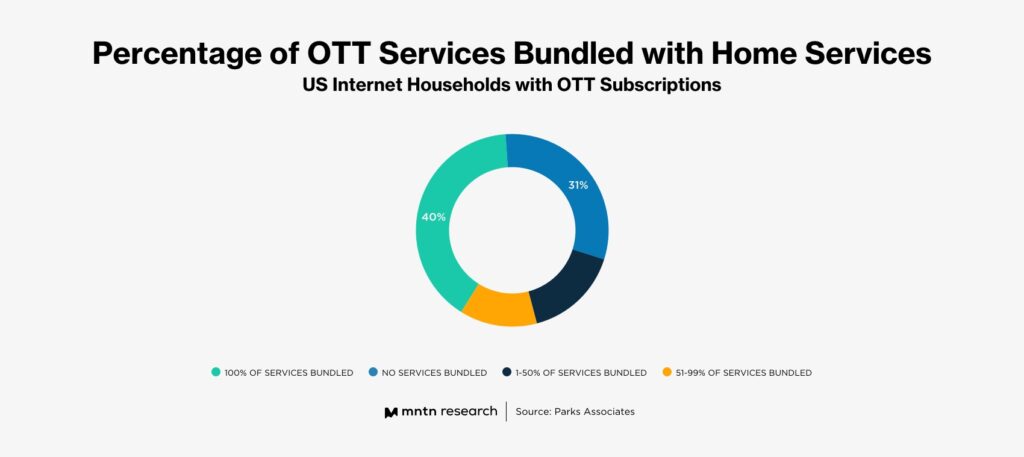Research Digest
CTV Viewers Look to OTT Bundles From Their Home Service Providers
by Isabel Greenfield3 min read
Abstract
- Home service providers are making it easier to manage multiple streaming services by offering a convenient bundling option.
- 40% of streaming households have chosen to bundle all of their services through their home service providers.
- The mobile ecosystem had a similar trajectory, resulting in a slowdown in app downloads.
With so many options, streamers want to simplify

There are a lot of choices when it comes to streaming, from which provider and device to use, to what channels to subscribe to. Not to mention selecting a show when it’s finally time to watch. As streaming has entered the mainstream, the choice of services has fluctuated as apps launched, consolidated, and added more subscription options. Throughout this fluctuation, there has been an interesting player that has helped streamline this process–streamers’ home services providers.
Home services providers, like Verizon, are streamlining the way that their customers can sign up for their streaming services of choice. Rather than signing up individually for each service (streamers have an average of 4 at any one time), TV watchers can consolidate these charges through their home service provider. Forty percent of viewers surveyed by Park Associates bundle all their services through their provider, opting for one consolidated bill over a more fragmented approach.
The move away from cable was one often motivated by costs. However, as avid TV watchers subscribed to their ideal mix of channels, it became an unwieldy mix of individual subscriptions. Now, home service providers are giving their customers the simplified and unified bill of the previous cable-filled era; this time with options. Bundling has become a hallmark of the streaming world, allowing viewers to pay for what they want to watch and not for what they don’t.
Mirroring Mobile
If this pattern of rapid expansion to the point of overwhelm, followed by a desire for consolidation feels familiar, that’s because this happened before with emerging technology. With the introduction of the smartphone, the creation of apps boomed. Everyone uttered the phrase “there’s an app for that” and there was. However, as downloaded apps overflowed users’ devices, creating page after page of options, the utility they touted was diminished by the sheer volume of apps.
ComScore reported in 2014 that the average smartphone user downloaded zero apps per month. Only 8.4% even downloaded one app per month. They found that instead, most users spent 42% of their time within their most-used app. “The latest thing in apps should be fewer apps,” the author suggested.
Streaming has followed in the smaller screen’s footsteps. At the outset of the streaming revolution, the boundaries were pushed as entertainment, news and sports companies rushed to make their own streaming channels. Some businesses failed, while others were acquired and content was gathered into convenient mega-channels (ex. Disney consolidated the National Geographic channel under the Disney+ umbrella). Media companies have started to simplify the home screen, while home service providers offer even more utility to their subscribers by simplifying their bills.
Conclusion
Home service providers are offering a convenient solution to the streamers’ subscription problem: bundling. Much like the expansion and consolidation of the mobile app ecosystem, streaming is going through a renaissance as content ownership shifts and moves under the umbrella of a larger channel. Offering one monthly bill makes it even simpler for viewers to start and keep streaming.
Subscribe to the MNTN Research Weekly
Sign up to receive a weekly feed of curated research, sent straight to your inbox.
Resources